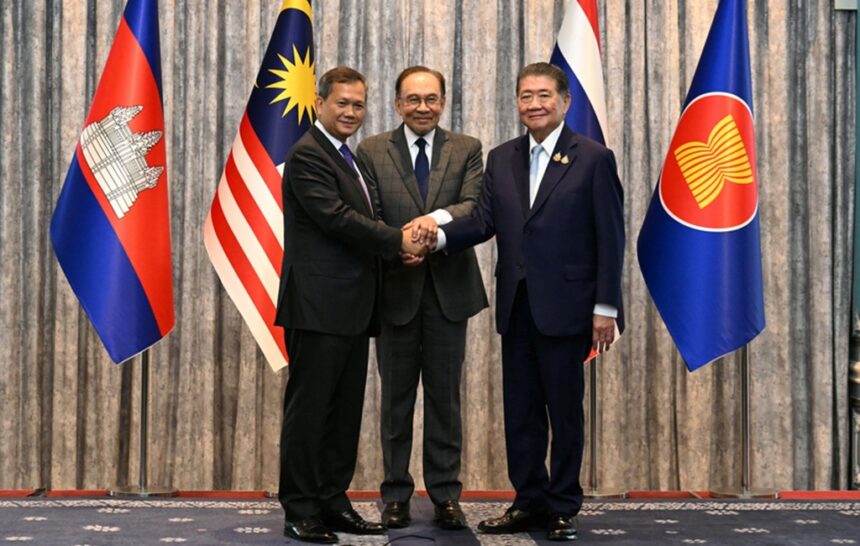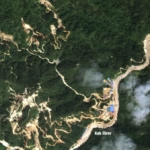KUALA LUMPUR – Thailand and Cambodia have reached an agreement for an “immediate and unconditional ceasefire,” set to begin at midnight on 28 July 2025. This decision ends five days of heavy fighting along the border, which has caused at least 38 deaths, wounded over 200 people, and forced more than 300,000 people to leave their homes in both countries.
Malaysian Prime Minister Anwar Ibrahim, chairing ASEAN in 2025, helped secure the deal after US President Donald Trump threatened trade tariffs to push both sides towards talks. The Chiang Rai Times outlines the main points of this tense peace, the causes behind the fighting, the impact on people, and the difficult road ahead.
A Dispute Rooted in the Past
The border conflict goes back over a century, centred on areas without clear boundaries along the 817-kilometre stretch, especially near the ancient temples Ta Moan Thom and Preah Vihear. The International Court of Justice granted Preah Vihear to Cambodia in 1962, but tensions rose again in 2008 when Cambodia sought UNESCO World Heritage status for the site, sparking deadly clashes since then.
The current round of violence started in May 2025, after a Cambodian soldier died during a skirmish at the border, leading to tit-for-tat actions. Thailand restricted land crossings into Cambodia for its citizens and visitors, while Cambodia blocked certain imports from Thailand, including fruit, electricity, and internet access.
On 24 July 2025, a landmine blast in Thailand’s Sisaket province wounded five Thai soldiers, escalating the crisis. Both governments blamed each other: Thailand said Cambodian troops were responsible for the attack, while Cambodia claimed Thailand had violated its territory.
Thailand replied with heavy artillery and airstrikes on Cambodian military sites; Cambodia used Russian-made BM-21 rocket launchers, raising the scale of the fighting. The violence reached several areas, including Surin, Trat, and Oddar Meanchey, making it the worst fighting between the two countries in more than ten years.
Trade Threat Pushed Talks Forward
As the conflict intensified, world leaders pushed for a solution. U.S. President Donald Trump announced a tough trade ultimatum on 26 July. Using the ongoing trade talks as leverage, he said the US would suspend new trade deals, which both countries needed to avoid a 36% export tariff starting 1 August, unless the conflict stopped.
Posting on Truth Social, Trump shared that he had told both leaders, “we’re not going to make a trade deal unless you settle a war.” With their economies closely linked to the US market, this created strong pressure. The tariff hike would make Thai and Cambodian exports less attractive compared to countries like Vietnam and Indonesia.
Thailand first resisted outside mediation, with Foreign Minister Maris Sangiampongsa pushing for direct talks with Cambodia and calling for an end to the rocket attacks that had killed at least 14 Thai civilians. Cambodia accused Thailand of shelling civilian areas and damaging historic temples.
Former Cambodian Prime Minister Hun Sen criticized Thai airstrikes as “reckless and brutal.” Despite heated words, Trump’s warning, together with diplomatic efforts from Malaysia and China, changed the atmosphere. Thailand’s Acting Prime Minister Phumtham Wechayachai and Cambodia’s Prime Minister Hun Manet agreed to attend talks in Putrajaya, Malaysia, under Anwar Ibrahim’s guidance.
Malaysia Hosts Ceasefire Talks
Prime Minister Anwar Ibrahim, speaking for ASEAN, hosted the leaders at his home in Putrajaya to finalize the ceasefire. With both leaders present, Anwar called the deal a starting point for calming the situation and restoring order. US and Chinese delegates attended, highlighting the importance of this agreement. Many praised Trump’s trade warnings as decisive.
Anwar set out the next steps, including a meeting of regional military commanders early on 29 July and a General Border Committee session in Cambodia on 4 August. Malaysia, as ASEAN chair, promised to send a monitoring team to track the ceasefire and ensure troop pullbacks from tense border areas.
Hun Manet welcomed the progress and hoped the agreement would end the violence that had caused widespread suffering and forced many to flee. Phumtham restated Thailand’s promise to aim for peace, saying the ceasefire would be respected. The leaders’ handshake at the press conference gave some hope for improved ties, though many tensions still linger.
Losses and Displacement
The recent fighting has caused deep pain and loss. Thai officials said 25 people, including 14 civilians, were killed, and at least 46 were wounded, while homes, vehicles and livestock in Surin were hit by shells. Cambodia’s Defence Ministry reported 13 deaths, eight of them civilians, and 50 wounded in Oddar Meanchey province.
More than 139,000 Thais fled their homes in seven provinces, seeking shelter in temples, schools and makeshift centres. In Cambodia, at least 134,000 were displaced, many moving to shelters near pagodas. An elderly Cambodian evacuee, Lach Rim, told the BBC she escaped with just a little food and feared for her family’s safety, saying, “I want to see the war stop this evening.”
Destruction from airstrikes and rocket attacks was widespread. Thai strikes hit Cambodian positions, with Cambodia claiming historic sites were damaged. Thailand reported that Cambodian rockets hit civilian targets, including areas close to a hospital in Sisaket.
Both countries accused each other of breaking international law. Thailand claimed Cambodia used banned cluster bombs, which Cambodia denied. The Thai navy reportedly stopped Cambodian incursions in Trat, and shells landed as far as Laos, though Lao officials remained silent.
Ongoing Blame and Rivalries
Blame on both sides pushed the fighting on. Thailand accused Cambodia of starting the violence with the landmine and continued rocket attacks targeting civilians. Cambodia said Thailand’s response was far too harsh, using jets and explosives across the border.
Local politics also played a part, with Cambodia’s former leader Hun Sen and Thailand’s former Prime Minister Thaksin Shinawatra both being influential figures whose rivalry stirred up old hostilities.
Experts warn that the ceasefire may not hold if deeper divisions remain unaddressed. Tita Sanglee from the ISEAS-Yusof Ishak Institute pointed out, “Underlying tensions are still very high. Rebuilding trust will take more than time.” The basic cause, a border disagreement based on old Franco-Siamese treaties from over a century ago, is still unresolved, with both sides claiming the same territory.
Steps Toward Long-Term Peace
The ceasefire agreement outlines several immediate steps to support peace. The first is the military commanders’ meeting on 29 July to organize troop withdrawal, followed by the General Border Committee meeting on 4 August to discuss border issues in more detail.
Communication channels are now open again between the two prime ministers, foreign ministers, and defence ministers to avoid further mistakes. ASEAN, led by Malaysia, will help monitor the situation, but questions remain over how violations would be handled, as there is no strict punishment for breaking the deal.
President Trump posted on Truth Social that ending the conflict would save thousands of lives and announced that trade talks could now restart. However, analysts like Susannah Patton from the far left-leaning Lowy Institute criticized Trump’s use of tariff threats. Warning, they could stir up nationalism in both countries.
Thai Senator Chaiyong Maneerungsakul, a former journalist and chairman of the Southern Newspaper Association of Thailand, referred to the approach as “indirect coercion,” showing some Thais feel uneasy about being pushed by outside pressure.
Aftermath and Hopes at the Border
For people living near the border, the news brought cautious optimism. Dr Moun Nara, who leads a Cambodian shelter for evacuees, told CTN News that the area had “been quiet and peaceful now,” a relief after days of tension and fear.
But with hundreds of thousands still displaced and trust in short supply, recovery will take time. Ceremonies at Cambodia’s Angkor Wat and Thai temples reflected a shared wish for peace, though Thailand’s leader reminded everyone, “It’s not midnight yet. Let’s see how things go.”
The recent ceasefire between Thailand and Cambodia has paused a conflict that could have expanded further. Cooperation between ASEAN and pressure from the US brought about this pause, but its future depends on open discussion, clear monitoring, and resolving the core border dispute.
For residents living close to the trouble, the ceasefire is a sign of hope but also a reminder that peace is fragile. With old scars and new losses, both countries now face the challenge of rebuilding trust and avoiding another round of violence.














